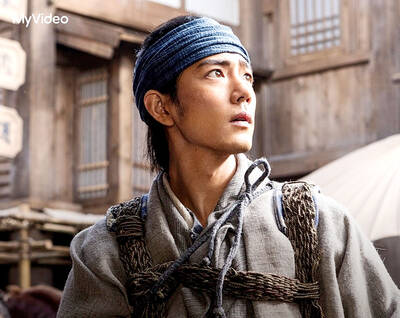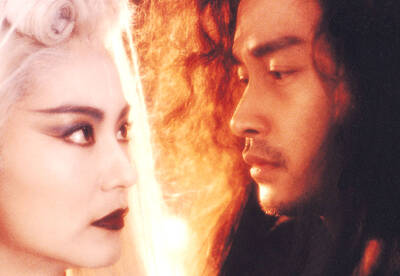Belarus’s strongman leader Alexander Lukashenko, condemned as Europe’s last dictator, last Thursday took his youngest son Kolya, whom he calls his “talisman,” for his first day at a shinily renovated school.
The first item on state television news showed Lukashenko and his seven-year-old son walking hand-in-hand into the school in a village outside the capital Minsk, close to one of the president’s country houses.
Lukashenko has called the fair-haired boy — born in an extra-marital relationship — his lucky charm. “He is my talisman, my cross,” Lukashenko once said of the boy.

Photo: AFP
照片:法新社
The identity of Nikolai’s mother is not officially reported. Lukashenko himself has said in an interview that she is a doctor. Lukashenko’s wife is rarely seen in public.
Nikolai, known by his nickname Kolya, often accompanies Lukashenko to official events, sometimes wearing a miniature military uniform. He appeared at his father’s inauguration ceremony and even at a meeting with Pope Benedict XVI.
Lukashenko said last year that his son “would go to the most ordinary school,” but the school he picked was recently renovated at a reported cost of US$3 million (NT$87.05 million) and equipped with a modern gym and a swimming pool.
Kolya, dressed in a gray suit, gave his new teacher a bunch of flowers and sat with his classmates in 1B, while his father dropped in, telling pupils to “study hard and be cheerful and healthy.”
Lukashenko also gave a speech to the whole school and parents, saying that “children are our greatest treasure.”
The first day of school on Sept. 1 is marked with elaborate ceremony in the former Soviet Union, with children dressed in formal clothes and bringing huge bouquets of flowers for teachers.
(AFP)
白俄羅斯強人亞歷山大‧盧卡申科上週四帶著他的小兒子柯亞,首日到一所被翻修而光亮奪目的學校就學。盧卡申科被譴責為歐洲最後一位獨裁者,他則稱其小兒子為他的護身符。
國家電視新聞頻道的第一則新聞,即是盧卡申科與其七歲兒子手牽手,步行前往首都明斯克近郊,一座靠近總統鄉間別墅村落的學校。
盧卡申科稱這位備受寵愛的男孩─其私生子─為其護身符。他說:「他是我的護身符,我的十字架。」
尼可拉親生母親的身份並未正式被報導。盧卡申科已在一次訪談中親口透露,她是一位醫師。盧卡申科的妻子,也鮮少公開露面。
小名為柯亞的尼可拉,經常伴隨盧卡申科出席正式場合,有時會穿迷你版的軍服。他曾出現在父親的就職典禮,甚至現身教宗本篤十六世的會面場合。
盧卡申科說,去年他兒子「原本要去再平凡不過的學校」,但是他選擇的該所學校,直到最近才完成翻修,據報導耗資達三百萬美元(新台幣八千七百零五萬元),且校內有一座現代體育館與一座游泳池。
身穿灰色西裝的柯亞,獻給他的新老師一大束花,並且與同班同學一同坐在1B的教室,而他父親也順道進入該教室,勉勵學生要「用功念書,並且保持愉快與健康」。
盧卡申科也對該校師生與家長發表演說,他說:「孩童是我們最大的財富。」
這個前蘇聯盟國的白俄羅斯,以排場浩大的儀式慶祝九月一日開學日。當天學童穿正式服裝,並且帶大束鮮花獻給老師。
(法新社/翻譯:林亞蒂)

Have you ever seen a circular intersection where cars continuously flow in one direction around a central island? That is a “roundabout,” a well-known alternative to traditional intersections. Drivers enter and exit at different points without relying on traffic lights. Their primary purpose is to improve traffic flow and minimize the likelihood of high-speed collisions, particularly dangerous T-bone and head-on crashes. Roundabouts have existed and been implemented for over a century. In the 1960s, the modern roundabout emerged in the UK, with added rules for yielding. Unlike intersections with red lights, roundabouts allow vehicles to continue moving at a

A: So you’re reading Jin Yong’s martial arts novel again? B: Yup, Jin’s novels are so fascinating, especially the trilogy: “Legends of the Condor Heroes,” “Return of the Condor Heroes,” and “Heaven Sword and Dragon Saber.” A: The late novelist published his first story in 1955, which means this year marks the 70th anniversary of his “wuxia” world. B: Wasn’t an English version of “Legends of the Condor Heroes” also released in 2018? A: Yes, but the debate over the translation of kung fu moves continues — like the evil move “Nine Yin Skeleton Claw.” A: 你又在重讀金庸的武俠小說啦? B:

If you’ve recently spotted adults parading around with cuddly toys dangling from their designer handbags, your eyes haven’t been deceiving you. The playful trend of adorning bags with cute charms has become popular among people of various ages. Plushies like Labubu and anime and manga characters such as Chiikawa have become must-have accessories that make personal statements. The practice of attaching charms to personal items has been common across cultures throughout history. In ancient civilizations, charms were often used as symbols of protection, good luck, or identity. Fast-forward to more modern times, and style icons like Jane Birkin, a

A: Apart from Jin Yong, the late martial arts novelists Liang Yusheng and Gu Long were also very popular. B: Wasn’t Liang a pioneer of the “new school” wuxia genre in the 20th century? A: Yup, I really like his Tianshan mountain series. All the characters — such as the “White Haired Demoness” — are so vivid. B: The roles in Gu’s books are lively, too — like the “Fragrant Commander” Chu Liuxiang. A: And the TV drama adapted from the Chu Liuxiang series swept across Taiwan in the 1980s, with ratings surging over 70 percent at that time.